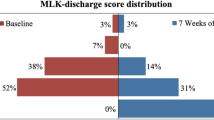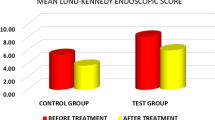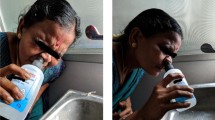Abstract
Low-concentration hypochlorous acid (HOCl) is an endogenous antibacterial and antiviral agent. The purpose of this study was to evaluate the effectiveness of HOCl irrigation in patients with chronic rhinosinusitis (CRS) refractory to medical therapy. Forty-three adult patients (mean age 45.5 years) were enrolled in this study. They were randomly chosen to receive nasal irrigation with either low-concentration HOCl generated by a Salicid device (n = 21), or a placebo (saline; n = 22) for 8 weeks. The outcome measures were scores on the 20-Item SinoNasal Outcome Test (SNOT-20), rhinosinusitis disability index (RSDI), nasal endoscopic score, and bacterial cultures. The SNOT-20 scores were significantly lower in the HOCl group than in the placebo group after 2 weeks of treatment (p < 0.05) and remained lower after 4 weeks of treatment. With respect to the RSDI scores, there was a significant improvement in the HOCl group at 1 week after treatment and in both groups at 2 weeks after treatment (p < 0.05). There were no significant differences in the endoscopic scores between the two groups after the treatment. The bacterial culture rates were lower in the HOCl group than in the placebo group after 4 weeks of treatment, but this was not significant (p > 0.05). Our results showed that low-concentration HOCl irrigation resulted in a greater improvement in CRS symptoms as compared to saline irrigation.




Similar content being viewed by others
References
Rabago D, Pasic T, Zgierska A, Mundt M, Barrett B, Maberry R (2005) The efficacy of hypertonic saline nasal irrigation for chronic sinonasal symptoms. Otolaryngol Head Neck Surg 133(1):3–8
Lanza D, Kennedy D. Adult rhinosinusitis defined. Report of the hinosinusitis Task Force Committee Meeting. Otolaryngol Head Neck Surg 117:4–5
Heatley DG, McConnell KE, Kille TL, Leverson GE (2001) Nasal irrigation for the alleviation of sinonasal symptoms. Otolaryngol Head Neck Surg 125(1):44–48
Rudmik L, Soler ZM (2015) Medical therapies for adult chronic sinusitis: a systematic review. JAMA 314(9):926–939
Parikh A, Scadding G, Darby Y, Baker R (2001) Topical corticosteroids in chronic rhinosinusitis: a randomized, double-blind, placebo-controlled trial using fluticasone propionate aqueous nasal spray. Rhinology 39(2):75–79
Zeiger RS (1992) Prospects for ancillary treatment of sinusitis in the 1990s. J Allergy Clin Immunol 90(3):478–495
Druce H (1990) Adjuncts to medical management of sinusitis. Otolaryngol Head Neck Surg Off J Am Acad Otolaryngol Head Neck Surg 103 (5 (Pt 2)):880–883
Parnes SM, Chuma AV (2000) Acute effects of antileukotrienes on sinonasal polyposis and sinusitis. Ear Nose Throat J 79(1):18
Wald ER, Applegate KE, Bordley C, Darrow DH, Glode MP, Marcy SM, Nelson CE, Rosenfeld RM, Shaikh N, Smith MJ (2013) Clinical practice guideline for the diagnosis and management of acute bacterial sinusitis in children aged 1 to 18 years. Pediatrics 132(1):e262–e280
Wang Y-H, Yang C-P, Ku M-S, Sun H-L, Lue K-H (2009) Efficacy of nasal irrigation in the treatment of acute sinusitis in children. Int J Pediatr Otorhinolaryngol 73(12):1696–1701
Shoseyov D, Bibi H, Shai P, Shoseyov N, Shazberg G, Hurvitz H (1998) Treatment with hypertonic saline versus normal saline nasal wash of pediatric chronic sinusitis. J Allergy Clin Immunol 101(5):602–605
Talbot AR, Herr TM, Parsons DS (1997) Mucociliary clearance and buffered hypertonic saline solution. Laryngoscope 107(4):500–503
Brown CL, Graham SM (2004) Nasal irrigations: good or bad? Curr Opin Otolaryngol Head Neck Surg 12(1):9–13
Papsin B, McTavish A (2003) Saline nasal irrigation: its role as an adjunct treatment. Can Fam Phys 49(2):168–173
Adam P, Stiffman M, Blake RL Jr (1998) A clinical trial of hypertonic saline nasal spray in subjects with the common cold or rhinosinusitis. Arch Fam Med 7(1):39
Cho HJ, Min HJ, Chung HJ, Park DY, Seong SY, Yoon JH, Lee JG, Kim CH (2016) Improved outcomes after low-concentration hypochlorous acid nasal irrigation in pediatric chronic sinusitis. The Laryngoscope 126(4):791–795
Kim KC, Singh B (1990) Hydrophobicity of mucin-like glycoproteins secreted by cultured tracheal epithelial cells: association with lipids. Exp Lung Res 16(3):279–292
Yu MS, Park HW, Kwon HJ, Jang YJ (2011) The effect of a low concentration of hypochlorous acid on rhinovirus infection of nasal epithelial cells. Am J Rhinol Allergy 25(1):40–44
Kim HJ, Lee JG, Kang JW, Cho HJ, Kim HS, Byeon HK, Yoon JH (2008) Effects of a low concentration hypochlorous acid nasal irrigation solution on bacteria, fungi, and virus. Laryngoscope 118(10):1862–1867
Piccirillo JF, Merritt MG, Richards ML (2002) Psychometric and clinimetric validity of the 20-item Sino-Nasal Outcome Test (SNOT-20). Otolaryngology Head Neck Surg 126(1):41–47
Senior BA, Glaze C, Benninger MS (2001) Use of the Rhinosinusitis Disability Index (RSDI) in rhinologic disease. Am J Rhinol 15(1):15–20
Lund VJ, Kennedy DW (1997) Staging for rhinosinusitis. Otolaryngol Head Neck Surg 117(3):S35–S40
Bhattacharyya N (2011) Incremental health care utilization and expenditures for chronic rhinosinusitis in the United States. Ann Otol Rhinol Laryngol 120(7):423–427
Mattos JL, Woodard CR, Payne SC (2011) Trends in common rhinologic illnesses: analysis of US healthcare surveys 1995–2007. In: International forum of allergy and rhinology, vol 1. Wiley Online Library, pp 3–12
Smith KA, Orlandi RR, Rudmik L (2015) Cost of adult chronic rhinosinusitis: a systematic review. Laryngoscope 125(7):1547–1556
Wei JL, Sykes KJ, Johnson P, He J, Mayo MS (2011) Safety and efficacy of once-daily nasal irrigation for the treatment of pediatric chronic rhinosinusitis. Laryngoscope 121(9):1989–2000
Bachmann G, Hommel G, Michel O (2000) Effect of irrigation of the nose with isotonic salt solution on adult patients with chronic paranasal sinus disease. Eur Arch Otorhinolaryngol 257(10):537–541
Rabago D, Zgierska A, Mundt M, Barrett B, Bobula J, Maberry R (2002) Efficacy of daily hypertonic saline nasal irrigation among patients with sinusitis: a randomized controlled trial. J Fam Pract 51(12):1049–1055
Tomooka LT, Murphy C, Davidson TM (2000) Clinical study and literature review of nasal irrigation. Laryngoscope 110(7):1189–1193
Palmer K (1960) Reduction of sputum viscosity by a water aerosol in chronic bronchitis. Lancet 275(7115):91
Georgitis JW (1994) Nasal hyperthermia and simple irrigation for perennial rhinitis: changes in inflammatory mediators. Chest J 106(5):1487–1492
Boek WM, Keleş N, Graamans K, Huizing EH (1999) Physiologic and hypertonic saline solutions impair ciliary activity in vitro. Laryngoscope 109(3):396–399
Bruch M (2007) Toxicity and safety of topical sodium hypochlorite. Karger Publishers, Basel, Switzerland
Block SS (2001) Disinfection, sterilization, and preservation. Lippincott Williams & Wilkins
Lapenna D, Cuccurullo F (1996) Hypochlorous acid and its pharmacological antagonism: an update picture. General Pharmacol Vasc Syst 27(7):1145–1147
Wang L, Bassiri M, Najafi R, Najafi K, Yang J, Robson M (2007) Hypochlorous acid as a potential wound care agent. J Burns Wounds 6(5):65–79
Acknowledgements
This paper was supported by Konkuk University.
Author information
Authors and Affiliations
Corresponding author
Ethics declarations
Conflict of interest
All of authors declare that they have no conflict of interest.
Ethical approval
The protocol of the study was reviewed and approved by our institutional review board. All procedures performed were in accordance with the ethical standards of the institutional research committee and with the 1964 Helsinki declaration and its later amendments or comparable ethical standards.
Informed consent
Informed consent was obtained from all individual participants included in the study.
Rights and permissions
About this article
Cite this article
Yu, M.S., Kim, BH., Kang, SH. et al. Low-concentration hypochlorous acid nasal irrigation for chronic sinonasal symptoms: a prospective randomized placebo-controlled study. Eur Arch Otorhinolaryngol 274, 1527–1533 (2017). https://doi.org/10.1007/s00405-016-4387-5
Received:
Accepted:
Published:
Issue Date:
DOI: https://doi.org/10.1007/s00405-016-4387-5




